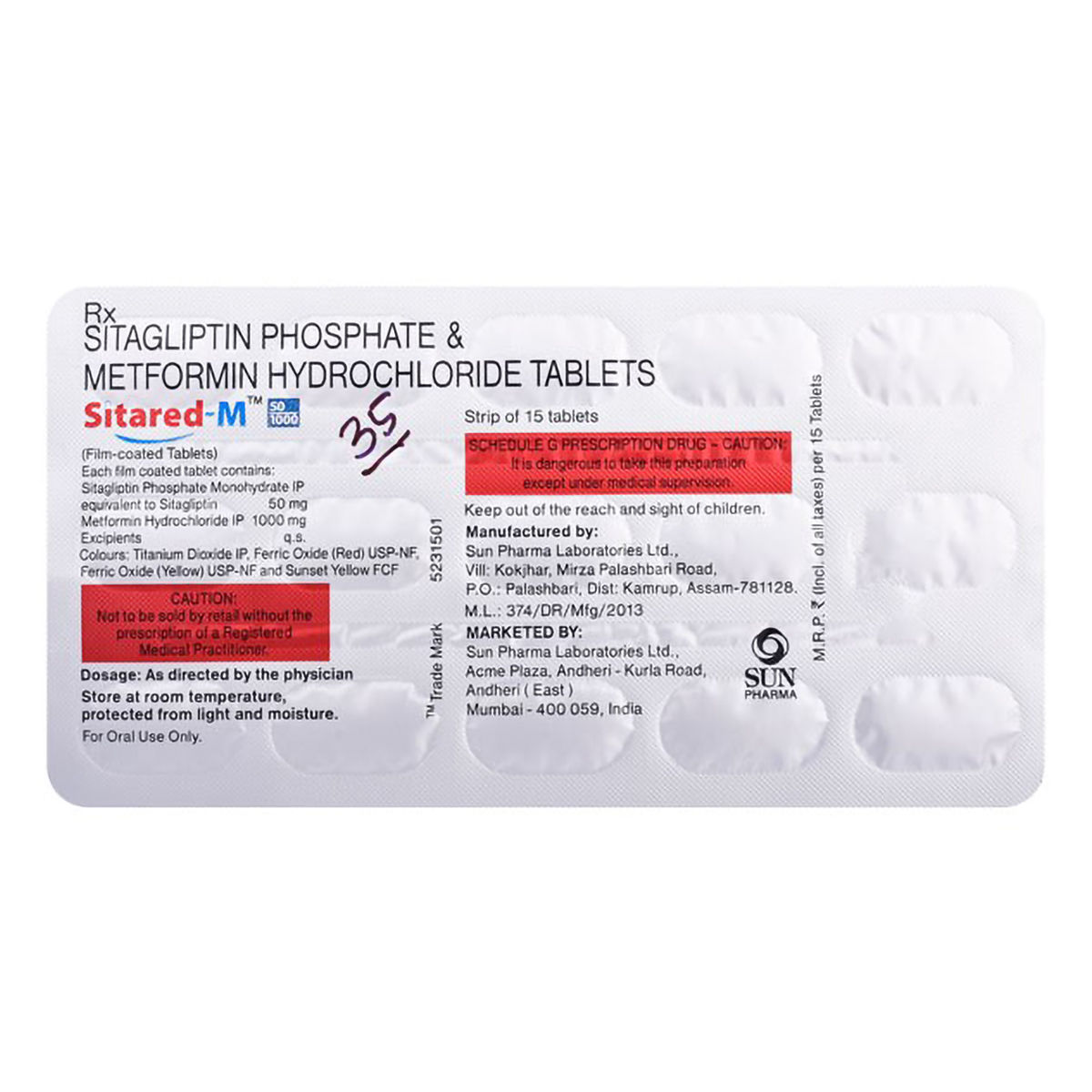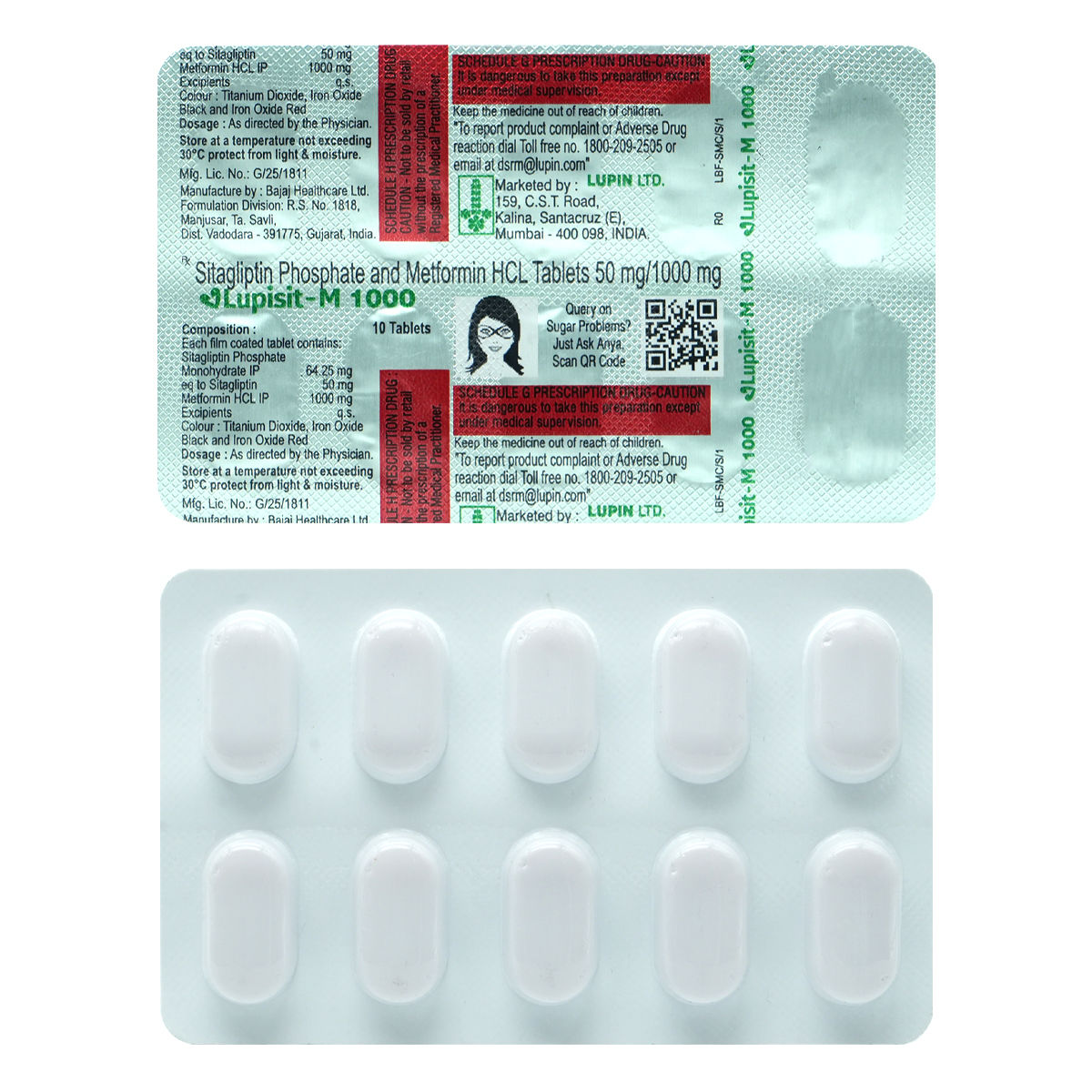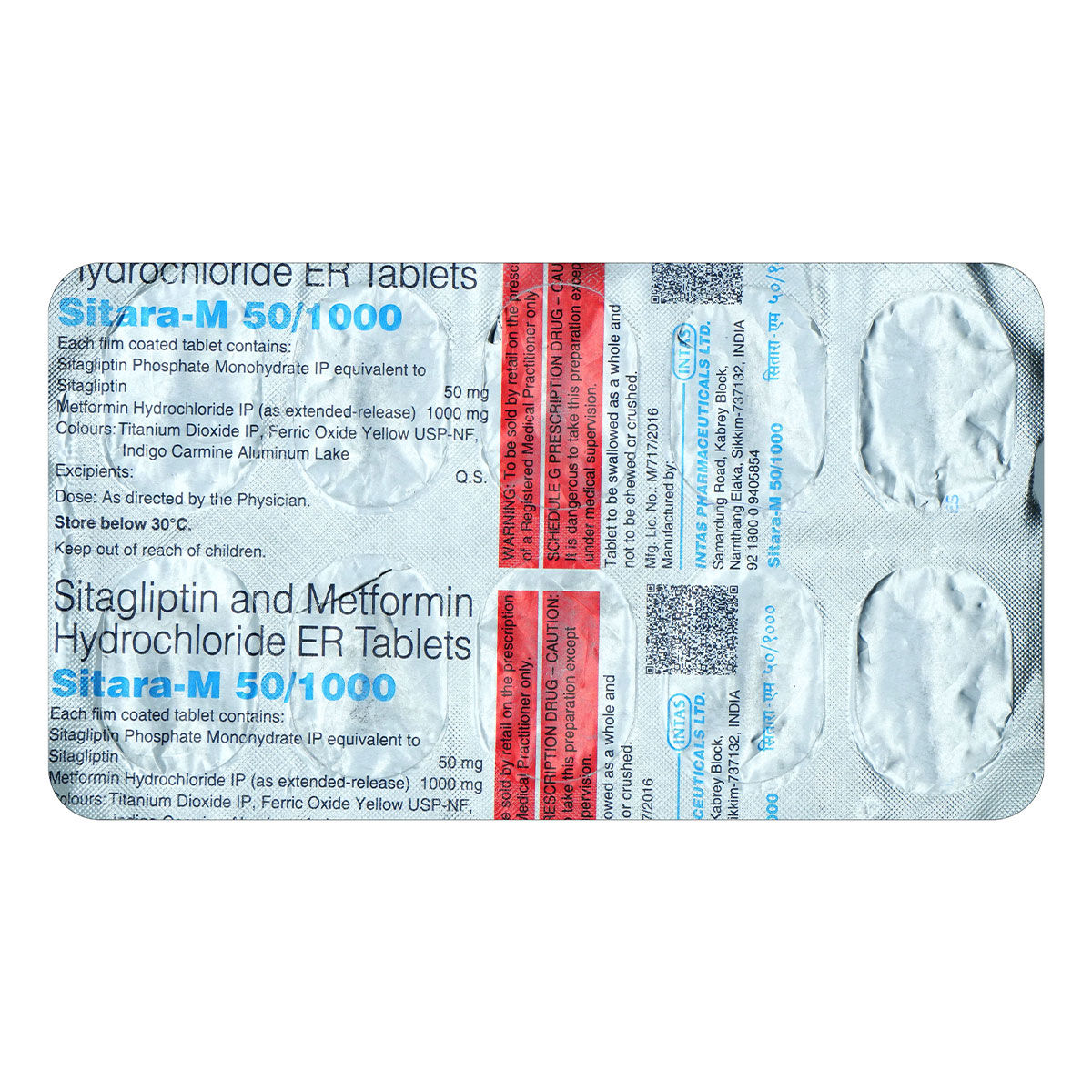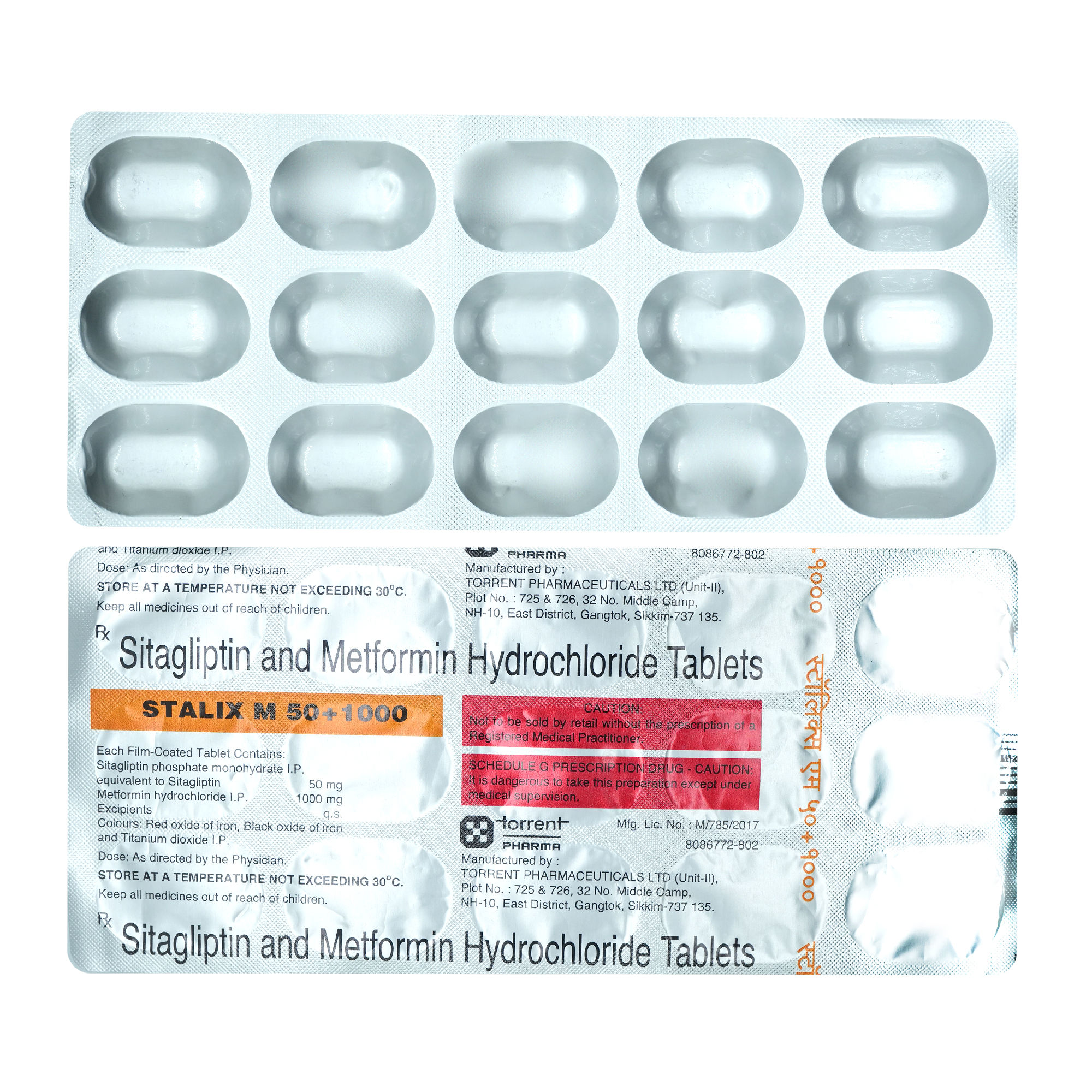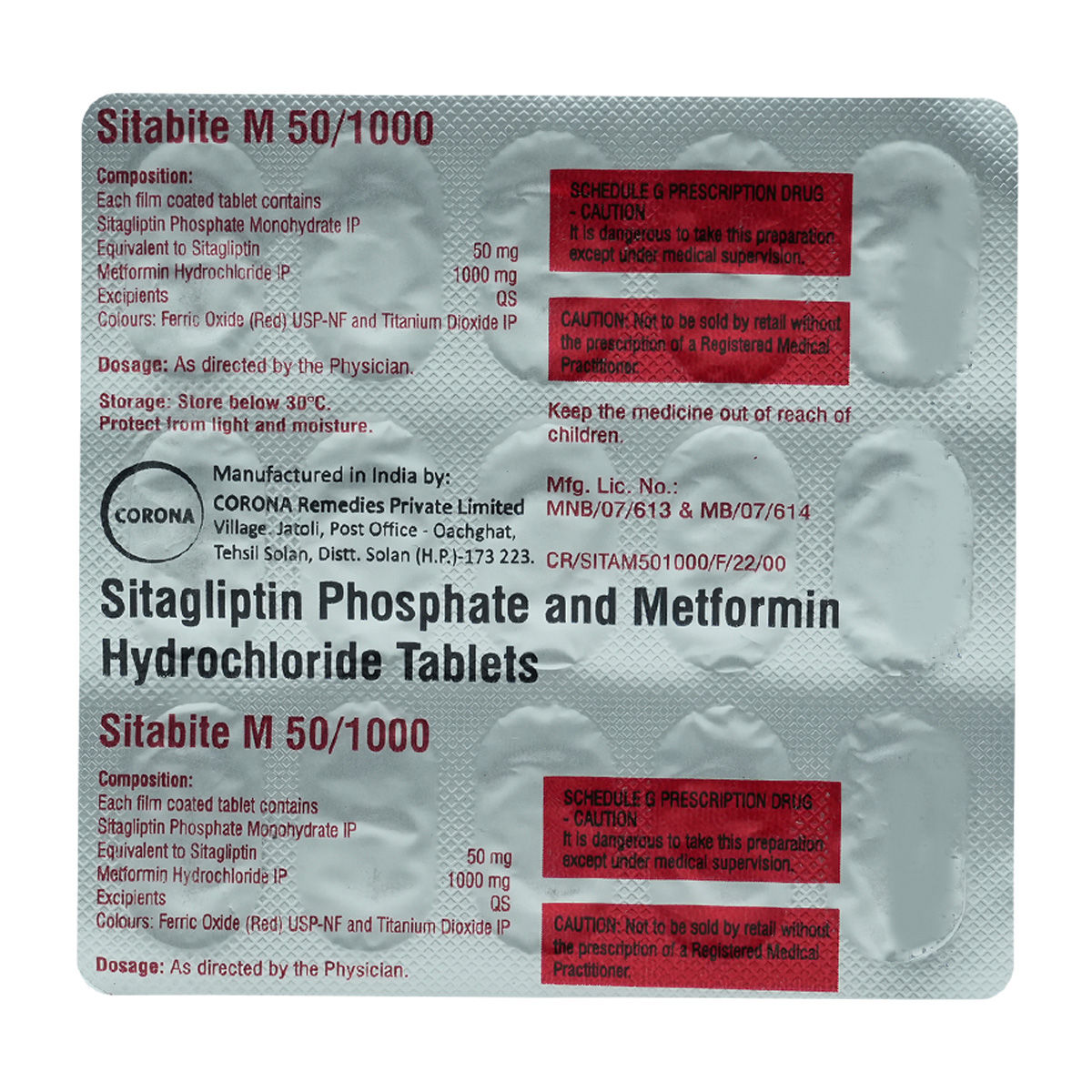Sitahenz-M 1000 Tablet 10's
Sitahenz M 1000 Tablet is used to treat Type 2 diabetes. It contains Sitagliptin and Metformin, which work by increasing the amounts of certain natural substances that lower blood sugar when it is high. Also, it lowers glucose production in the liver, delays glucose absorption from the intestines, and increases the body's sensitivity to insulin. Thus, it controls blood glucose levels from rising to very high after meals. The most common side effect is hypoglycemia (low blood glucose levels), characterised by dizziness, sweating, palpitations, hunger pangs, dry mouth and skin etc. So, to avoid hypoglycemia, you should not miss meals and should also carry some form of sugar with you. Other side effects include taste change, nausea, diarrhoea, stomach pain, headache, and upper respiratory symptoms.
₹145.8*
MRP ₹162
10% off
₹137.7*
MRP ₹162
15% CB
₹24.3 cashback(15%)
Free Delivery
With Circle membership
(Inclusive of all Taxes)
This offer price is valid on orders above ₹800. Apply coupon PHARMA10/PHARMA18 (excluding restricted items)
Know Your Delivery Time
Provide Delivery Location



Available Offers
 Prescription drug
Prescription drugWhats That
 46 people bought
46 people bought 
Secure Payment

India's Most Trusted Pharmacy

Genuine Products
Composition :
Manufacturer/Marketer :
Consume Type :
Return Policy :
Expires on or after :
About Sitahenz M 1000 Tablet
Sitahenz M 1000 Tablet belongs to the anti-diabetic agents used to treat type II diabetes. Type 2 diabetes is a condition in which either the body stops producing enough insulin (the hormone which helps to decrease sugar levels in the blood) or there is resistance to the action of insulin. As a result, insulin is produced in large amounts, but it cannot act on the body's organs.
Sitahenz M 1000 Tablet is a combination drug of Sitagliptin and Metformin. Metformin slows down the release of stored sugar from the liver, decreases the amount of sugar absorbed from the stomach, and improves how your body uses sugar. Sitagliptin increases the body's production of chemicals that cause the pancreas to release more insulin, which helps regulate blood sugar levels. Thus, Sitahenz M 1000 Tablet controls blood glucose levels from rising to very high after meals.
Sitahenz M 1000 Tablet should be taken with food to avoid an upset stomach. Sitahenz M 1000 Tablet should be taken at the same time of the day each time for best results. For better advice, your doctor will decide what dose should be taken, and it can change in time depending on your condition. The most common side effect of Sitahenz M 1000 Tablet is hypoglycemia (low blood glucose levels), characterized by dizziness, sweating, palpitations, hunger pangs, dry mouth and skin etc. So, to avoid hypoglycemia, you should not miss meals and should also carry some form of sugar with you. Other side effects include taste change, nausea, diarrhoea, stomach pain, headache, and upper respiratory symptoms.
Sitahenz M 1000 Tablet should not be stopped even if you feel better, without consulting the doctor as your sugar level keeps changing. If you stop taking Sitahenz M 1000 Tablet abruptly, it may increase your sugar levels, which could further increase the risk of eyesight loss (retinopathy), kidney (nephropathy) and nerve damage (neuropathy). Sitahenz M 1000 Tablet should not be taken if you have type 1 diabetes mellitus or severe kidney or liver disease. Please inform your doctor if you have any heart disease, are planning to get pregnant or are breastfeeding.
Uses of Sitahenz M 1000 Tablet
Directions for Use
Take Sitahenz M 1000 Tablet as prescribed by your doctor. Swallow it as a whole with water; do not crush, break or chew it.
Medicinal Benefits
Sitahenz M 1000 Tablet helps the pancreas produce more insulin, effectively utilise insulin, and decrease the excess sugar the liver makes. It helps control the rise of blood sugar levels after a meal. Besides this, it does not cause weight gain in prolonged use. Sitahenz M 1000 Tablet plays a vital role in controlling blood sugar levels. It prevents serious complications of diabetes like eyesight loss (retinopathy), kidney (nephropathy), nerve damage (neuropathy), diabetic foot ulcer and delayed wound healing.
How Sitahenz M 1000 Tablet Works
Storage
Side Effects of Sitahenz M 1000 Tablet
- Low blood sugar
- Runny nose
- Sore throat
- Upper lung infection
- Diarrhoea
- Nausea
- Vomiting
- Gas
- Stomach upset
- Indigestion
- General weakness
- Headache
What if I have taken an overdose of Sitahenz M 1000 Tablet
Drug Warnings
Sitahenz M 1000 Tablet should not be used in patients with type 1 diabetes or with diabetic ketoacidosis. Some diabetic patients, while taking Sitahenz M 1000 Tablet , might develop a rare but serious condition called lactic acidosis. In this condition, too much lactic acid accumulates in the blood, which can damage the workings of your liver and kidneys, which are required to eliminate excess lactic acid from the blood. Before you start taking Sitahenz M 1000 Tablet , tell your doctor if you’ve ever had pancreatitis (inflammation of the pancreas), kidney disease, and low vitamin B12 levels. Sitahenz M 1000 Tablet , when used with insulin, Sitahenz M 1000 Tablet may lower the blood sugar level, leading to hypoglycaemia, which can be fatal. In this case, your doctor may adjust the dose by lowering the insulin dose or Sitahenz M 1000 Tablet . Prolonged intake of Sitahenz M 1000 Tablet may lower your thyroid-stimulating hormone (TSH); hence, an annual check-up of TSH is recommended. In rare cases, you may also develop a serious skin reaction known as bullous pemphigoid that requires immediate medical attention. Tell your doctor if you will have a diagnostic test with an injection of dye or X-ray contrast agent. You should stop using Sitahenz M 1000 Tablet briefly before an X-ray procedure.
Drug-Drug Interactions
Drug-Drug Interactions
Login/Sign Up
Co-administration of Sitahenz-M 1000 Tablet 10's with Iodamide may increase the risk of kidney problems.
How to manage the interaction:
Taking Sitahenz-M 1000 Tablet 10's with Iodamide is not recommended, please consult a doctor before taking it. Do not discontinue the medications without consulting a doctor.
Co-administration of Ioglycamic acid with Sitahenz-M 1000 Tablet 10's can increase the risk of side effects.
How to manage the interaction:
Taking Sitahenz-M 1000 Tablet 10's with Ioglycamic acid is generally avoided as it can result in an interaction, please consult your doctor before taking it.
Co-administration of Iomeprol with Sitahenz-M 1000 Tablet 10's can increase the risk of side effects.
How to manage the interaction:
Taking Sitahenz-M 1000 Tablet 10's with Iomeprol is not recommended, please consult a doctor before taking it. Do not discontinue the medications without consulting a doctor.
Co-administration of Sitahenz-M 1000 Tablet 10's with Metrizamide together can cause the risk of lactic acidosis (when the body produces too much lactic acid ).
How to manage the interaction:
Taking Sitahenz-M 1000 Tablet 10's with Metrizamide is generally avoided as it can possibly result in an interaction, it can be taken if a doctor has advised it. However, if you experience headaches, muscle cramps or pain, contact a doctor immediately. Do not discontinue any medications without consulting a doctor.
Co-administration of Iopamidol with Sitahenz-M 1000 Tablet 10's can increase the risk of side effects.
How to manage the interaction:
Taking Sitahenz-M 1000 Tablet 10's with Iopamidol is not recommended, please consult a doctor before taking it. Do not discontinue the medications without consulting a doctor.
Co-administration of Sitahenz-M 1000 Tablet 10's and Iocarmic acid can increase the risk of lactic acidosis (when the body produces too much lactic acid).
How to manage the interaction:
Taking Sitahenz-M 1000 Tablet 10's with Iocarmic acid is generally avoided as it can result in an interaction. please consult your doctor before taking it.
Co-administration of Sitahenz-M 1000 Tablet 10's and Iocetamic acid can increase the risk of lactic acidosis (when the body produces too much lactic acid).
How to manage the interaction:
Taking Sitahenz-M 1000 Tablet 10's with Iocetamic acid is generally avoided as it can result in an interaction, please consult your doctor before taking it.
Co-administration of Iofendylate with Sitahenz-M 1000 Tablet 10's can increase the risk of side effects.
How to manage the interaction:
Taking Sitahenz-M 1000 Tablet 10's with Iofendylate is generally avoided as it can result in an interaction, please consult your doctor before taking it.
Co-administration of Ioglicic acid with Sitahenz-M 1000 Tablet 10's can increase the risk of side effects.
How to manage the interaction:
Taking Sitahenz-M 1000 Tablet 10's with Ioglicic acid is generally avoided as it can result in an interaction, please consult your doctor before taking it.
Co-administration of Ioversol with Sitahenz-M 1000 Tablet 10's can increase the risk of side effects.
How to manage the interaction:
Taking Sitahenz-M 1000 Tablet 10's with Ioversol is not recommended, please consult your doctor before taking it.
Drug-Food Interactions
Drug-Food Interactions
Login/Sign Up
Diet & Lifestyle Advise
- Include starchy veggies, proteins, and whole grains in your diet.
- Eat at regular intervals. Do not take a long gap between a meal or snack.
- Monitor your blood sugar level regularly.
- If you feel that your blood sugar level is going down and you are feeling weak, immediately eat sugar candies or drink sugary beverages. It will help to balance the blood sugar level in your body. So, it is advisable to keep sugar candies with you.
- Invest in at least 150 min of moderate-intensity physical activity or one hour and 15 minutes of high-intensity exercise every week.
- Lose weight gradually to achieve a healthy body mass index (18.5 to 24.9).
- Replace refined carbohydrate-containing foods with whole grain foods and increase the intake of fruits, veggies, and other fibre-enriched foods.
- Reduce intake of saturated fat (or hidden fats) in food like chips, crisps, pastries, biscuits, and samosas. Choose omega-3 fatty acid-containing oils for daily cooking. For frying, you can use palm oil, mustard oil, groundnut oil, rice bran oil, and safflower oil.
- Do not take stress as it may elevate your blood sugar level. You can adopt stress management techniques like mindfulness to control stress-related blood sugar changes.
- Opt for low-fat dairy products (low-fat yoghurt, fat-free milk, cheese, etc.).
- Keep your blood pressure as normal (140/90) as possible. As it reduces the risk of cardiovascular diseases in diabetes patients.
Habit Forming
Therapeutic Class
Sitahenz M 1000 Tablet Substitute

Increglip M 50/1000 Tablet 15's
₹13.07per tabletIstamet 50 mg/1000 mg Tablet 15's
₹10.38per tabletJanumet 50 mg/1000 mg Tablet 15's
₹22.80per tabletSitared M 50 mg/1000 mg Tablet 15's
₹10.38per tabletLupisit-M 1000 Tablet 10's
₹12.87per tablet
Product Substitutes
Alcohol
Caution
Avoid consumption of alcohol while on treatment with Sitahenz M 1000 Tablet .
Pregnancy
Caution
Sitahenz M 1000 Tablet is only recommended during pregnancy when the benefit outweighs the risk. Please consult your doctor before starting Sitahenz M 1000 Tablet if you are pregnant or planning to conceive.
Breast Feeding
Caution
Consult your doctor; Sitahenz M 1000 Tablet should be used in breastfeeding mothers only if the benefits outweigh the risks.
Driving
Caution
Drive only if you are physically stable and mentally focussed, If you experience drowsiness after taking these medications you should not drive or operate any machinery or vehicles.
Liver
Caution
If you have or have a history or evidence of any liver-related diseases, please consult the doctor before taking medicine.
Kidney
Caution
If you have or had a history or evidence of any kidney-related diseases, please consult the doctor before taking medicine.
Children
Caution
It is advisable to consult a doctor before using it.
FAQs
Country of origin
Manufacturer/Marketer address
Customers Also Bought
Disclaimer
Author Details
We provide you with authentic, trustworthy and relevant information
Recommended for a 30-day course: 3 Strips









